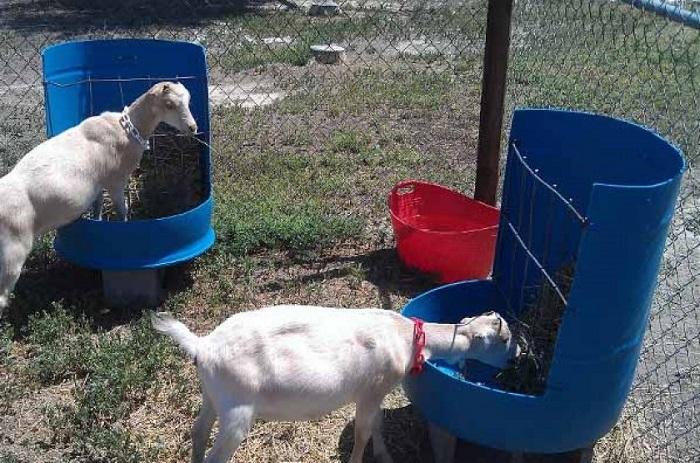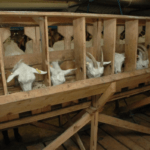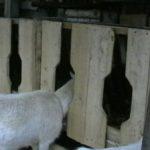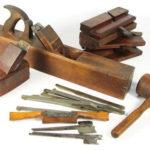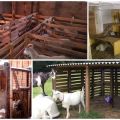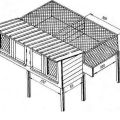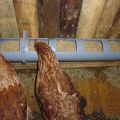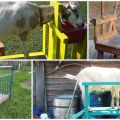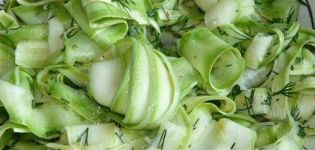Types of goat feeders and how to do it yourself, instructions and drawings
A well-crafted design of a goat feeder will make life easier for the owners, and will allow you to properly organize food intake. And it will be easier to clean up after goats, subject to the feeding conditions in the same place. There are several standard solutions, options for implementation at home. All of them will be considered, studied in detail with the attachment of video, drawings.
Appointment
A feeder is considered to be a special device designed for controlled dispensing, safe feed consumption and, preferably, simple in design. Experienced goat breeders know that an animal can be picky about food.
The trough organizes the feeding process itself. The goat is not a man. She does not understand why it is impossible to scatter the grass around the corral, and then also walk on it before eating. If there is a special compartment, the worries of the goat owners will decrease, and the animals will be more organized.
Basic requirements for any type of feeder
Whatever the design of the feeder, it must meet certain requirements. Especially when it comes to a home-made, not factory-made device. These include:
- Safety. The design must exclude the possibility of injury to animals, including young animals.
- Simplicity. Home craftsmen do not have sophisticated machines and equipment available. Therefore, the manufacturing option must be tied to a minimum cost of purchasing equipment, special tools, materials.
- Food safety. This is one of the main tasks for which the feeder is created. It is important that it was easy to put fodder, silage, grass in it and just as easily cleaned of the remnants of the "meal".
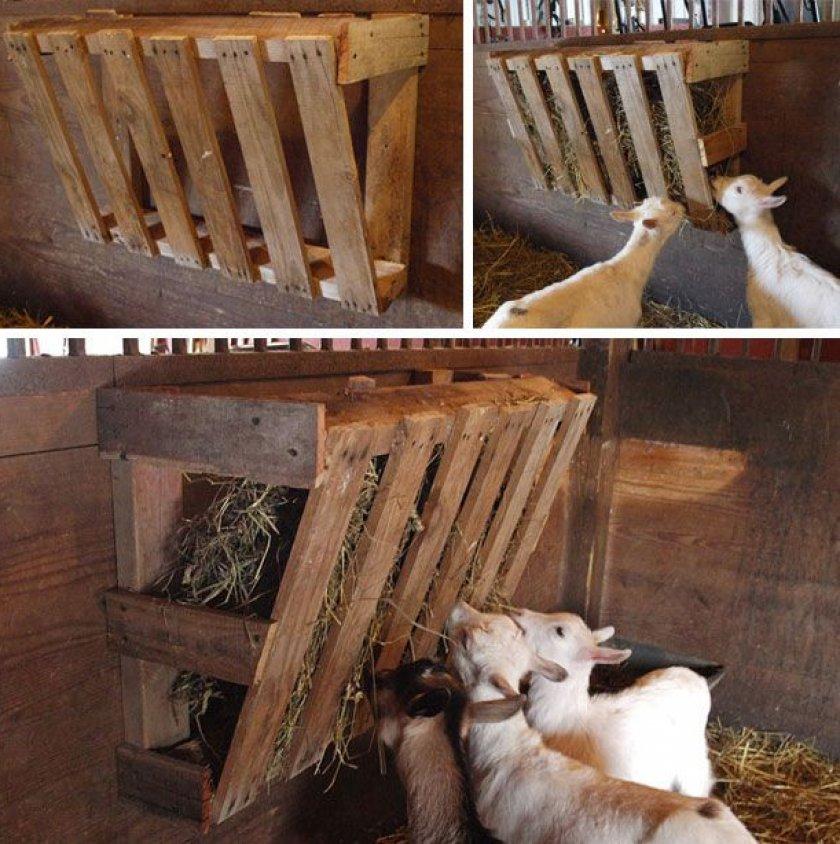
These are, in short, the basic conditions for the implementation of the project. It remains to choose the option you like, to start manufacturing.
Safety
Domestic goats often start behaving unpredictably: dividing territory, arranging fights, or jumping, climbing on some structures, just like their wild fellow tribesmen. The essence of a safe feeder is to exclude the possibility of injury to animals, to prevent the oppression of young animals by their elders.
Simplicity of design
We know from practice that simple solutions are not always the worst. The breeder does not have time for complex calculations, making a feeder using modern materials and technologies. And there is usually no extra money for this either.You need a simple, easily implementable goat feeder design in most situations. It is desirable to be collected by one person and for a minimum period (day, weekend).
Feed safety
Conventional feed can be found anywhere. And in this case, goats do not have a specific place for eating. Another thing is the feeder. So the goats will get used to eating in a strictly established corner of the corral and forage, and much less liquid feeding will go away. If only because it will become more difficult for the goat to get it out of the feeder.
Typical structures for feeding a goat herd
There are several types of designs depending on the type of feed. It is very important to understand this circumstance. Bulk feeders are not like liquid feeding devices for goats. Therefore, they are different in how they are implemented. Accordingly, you need to know in advance which option will be preferable for you. So, the typical types of feeders:
- for bulk feed;
- for a liquid mixture;
- for plant food.
And then we will consider each design separately with its pros and cons.

Loose feed
Popular among goat owners: mixed feed, bran, grain mixtures. They are classified in the free-flowing category. This choice is justified, since it allows the animals to gain weight, fat gain. As for the design of the feeder, it must meet 2 criteria: the safety of the feed and the maximum consumption of it by goats.
Liquid feed
Liquid fraction mixes are popular because of the various components that can be added to them. Including silos, vinasse, grain, diluted with water to the required consistency. In this case, the trough should consist of a pipe system, a special trough. A dry mix design will not work here.
Edible plant material
A separate category is made up of feeders for hay and other vegetable feed for goats. It is necessary to ensure that the goats do not drag the forage away, do not scatter it over the entire area of the pen. In the best way these conditions are met by a sennik, assembled from a wooden crate, gradually tapering downward. Other options are also possible.

Required tools
Before starting to implement the idea, you need to take care of the required equipment. Despite the choice of the simplest, easily assembled structures, it is impossible to do without tools and devices. It is recommended to use common wood, bars, boards and slats as the main material. They are easy to buy at any sawmill, warehouse.
The tools for working with them include:
- hacksaw or electric jigsaw, hand-held circular saw;
- electric drill, screwdriver;
- metalwork hammer;
- meter, ruler or tape measure.
Additional equipment includes: marker (pencil), drill bits, fasteners (screws, nails, steel corners), drills. If necessary, the set is adjusted for specific needs.
Recommendations for the manufacture of different feeders
The design is influenced by the type of feed that is supposed to nurture the animals. This will affect blueprints, feeder manufacturing costs, material and tool choices. You should also consider the location of the feeding area. So that it was comfortable for both the animals and the owners.
It is undesirable to use plastic, any polymers, metal. Goats are somewhat capricious, they will easily refuse to eat from the feeder, which somehow smells "wrong". Affects the design and size of animals. For young animals, babies are more suitable for a nursery, from where they can get food without problems.
One of the manufacturing options is shown in the video:
Nursery type
For little kids, a manger feeder is easy to build in half a day, even without the skills of a professional carpenter. That is, with your own hands, without complex equipment and mechanisms. The assembly is carried out in several stages. Let's consider it step by step:
- Lower frame.Its size is determined by the number of animals simultaneously kept in the pen. There should be enough food for everyone so that no one goes hungry. Legs are placed in the corners: they bind the structure, provide rigidity and serve as the basis for installation on the floor.
- Bottom. Gathered from tightly fitted boards. It is permissible to use a sheet of thick plywood, chipboard, OSB boards. No holes are provided in this element, otherwise the feed will spill out, scattered on the floor of the pen.
- Upper frame. Consists of longitudinal bars. Crossbars, short sections of boards, strips are attached to it. The step should not be too frequent - animals will not be able to stick their head in, eat normally.
The stages of assembling the feeder are shown in detail in the video:
Wooden
You can make a corner feeder with 2 wooden boards or pallets. They are used in the delivery of goods, and then thrown away as unnecessary. So there should be no problems with the material. One more nursery turns out, but in a different version.


Or you can do this:

From reinforcement
If there is access to scraps of reinforcing bars, as well as an electric welding installation, the feeding unit can be made of metal. The complexity of this version of the feeder is higher than that of a wooden one. But it is much stronger, which means it will last longer. Goats cannot move such a nursery, turn them over. But there are also disadvantages: the risk of injury to animals remains. Sharp, protruding parts should be minimized. Or hide them under the linings, clean them, drown them into the base.
For ease of perception, a drawing of the feeder with dimensions is provided.

There is also a variant of a compact metal feeder:

And street:

French feeders
France in terms of goat breeding has a tremendous experience, which is not a sin to borrow. Local small ruminants are similar to, but different from, nurseries.

By design, it is a box with holes cut in the walls to fit the size of the animal's muzzle. In fact, it is a variant of a universal feeder: it is allowed to lay both bulk feed and coarse forage here. Feeding takes place inside the device. This minimizes waste. Also, the French feeder allows goats to eat up almost everything that lies inside.
From pipes
From the materials remaining after replacing the sewage system, drainage devices at the dacha, ready-made feed dispensers are obtained. You will need plastic pipes with a diameter of 10 centimeters or more. It is undesirable to use used constructions that come into contact with waste products: this puts the goats at risk of infection.
The height of the feeder structure is up to 1.5 meters. The pipe is cut into 3 sections - 700, 200 and 100 millimeters. You will also need a branch, a tee. Further, the segments are joined together, as shown in the figure. Sharp edges and roughness must be sanded and removed. A lid is placed on top, the finished dispenser is attached to the wall of the goat pen with plumbing clamps.

From a plastic barrel
Great goat feeders come from orphaned plastic containers. You can use the container only after thorough cleaning, repeated washing with soap, and drying. An indispensable condition: the barrel must not contain residues of toxic liquids, materials (fuels and lubricants, solvents, paints). All these substances will lead to disease, death of animals.
Damaged containers with cracks, chips, shells and holes will not work. Next, choose 1 of 2 possible options for organizing the feeder - horizontal or vertical.
Horizontal
To begin with, place a clean, dry barrel on its side.Then successively mark 5-15 centimeters from the edge at the ends, so as to remove the "cover" from above. The resulting window will be filled with food. And in the side walls, holes should be made for feeding (such that the goat can stick its head).
In the bottom, it is advisable to drill several holes with a thin drill: this will ensure the drainage of the liquid, simplify the cleaning of the feeder. It remains to clean the sharp edges, make the structure heavier, or install in a wooden box-holder. The cut off part can be turned into a lid by attaching it to the barrel with hinges or string.
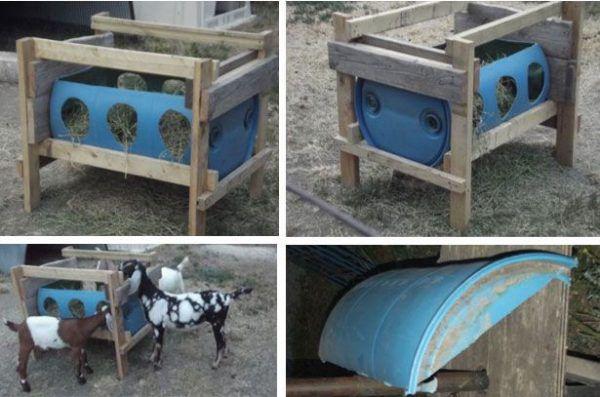
Vertical
The design is more complicated than the previous one in the sense that it will be necessary to accurately mark the barrel. Conventionally, the preparation of the feeder looks like the letter "G". Such figures should turn out 2. The height of the cut to the edge of the container should be equal to 20 centimeters. The vertical seam divides the barrel exactly in half. Next, you can close the resulting window with a fine mesh, leaving the goats with an opening at the bottom. The structure is attached to a solid base or weighted down.
